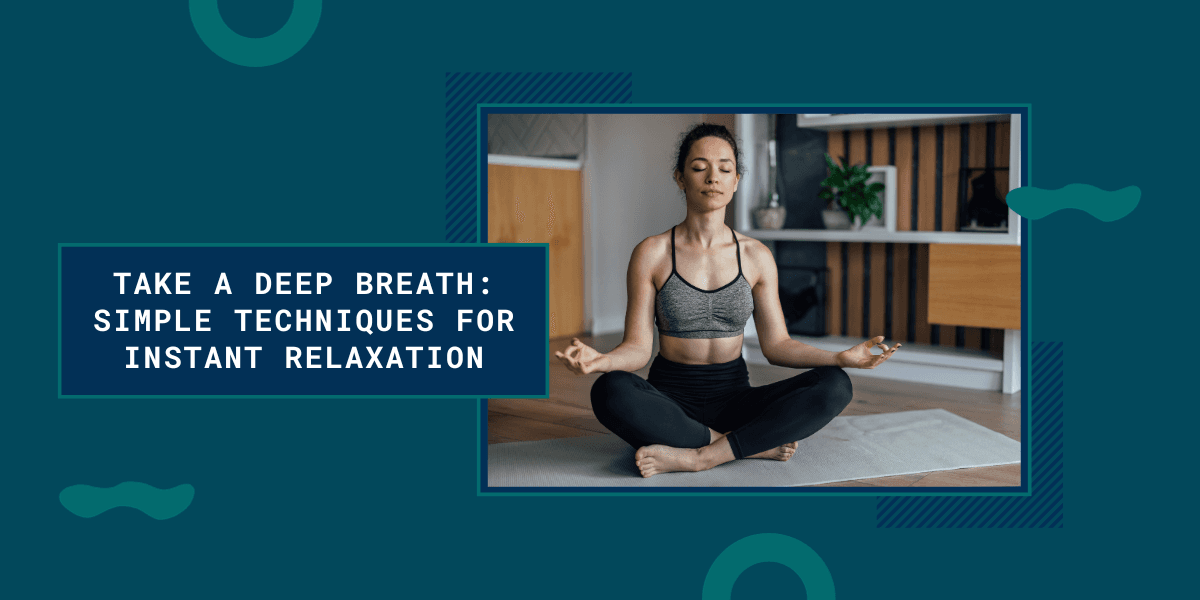Take A Deep Breath: Simple Techniques For Instant Relaxation

Introduction
Breathing is an essential part of life, and yet it’s something we often take for granted. However, the way we breathe can have a profound impact on our physical and emotional well-being, especially when it comes to managing stress and anxiety. In this blog, we’ll explore various relaxing breathing techniques that can help reduce stress and promote a sense of calm and relaxation.
Diaphragmatic Breathing
Diaphragmatic breathing, also known as belly breathing, is a simple technique that involves breathing deeply into the diaphragm, the muscle located just below the lungs. When we breathe deeply into the diaphragm, we are able to slow down our breathing rate and reduce the amount of oxygen in our bloodstream, which can have a calming effect on the body.

To practice diaphragmatic breathing, start by finding a quiet and comfortable place to sit. Place one hand on your chest and the other on your stomach, then take a deep breath in through your nose, filling your lungs and allowing your belly to expand. Hold your breath for a few seconds, then slowly exhale through your mouth, letting your belly contract. Repeat this process several times, focusing on breathing deeply into your diaphragm.
Progressive Muscle Relaxation
Progressive muscle relaxation is a technique that involves tensing and relaxing different muscle groups in the body, which can help to reduce physical tension and stress. The idea behind this technique is that by focusing on the physical sensations of tension and relaxation, you can become more aware of when your muscles are tense and more easily relax them.

To practice progressive muscle relaxation, start by tensing a specific muscle group, such as your fists, for a few seconds, then releasing the tension and noticing the difference in the physical sensations between tension and relaxation. Repeat this process with different muscle groups, moving up your body from your feet to your head.
Alternate Nostril Breathing
Alternate nostril breathing is a technique that involves alternating the nostril you breathe through, which can help to balance the flow of air and energy in the body and promote relaxation. This technique is often used in yoga and meditation practices and can be a useful tool for reducing stress and anxiety.

To practice alternate nostril breathing, sit comfortably with your back straight and your eyes closed. Using your right hand, close your right nostril with your thumb and take a deep breath through your left nostril. Then, close your left nostril with your ring and pinky fingers, release your right nostril, and exhale through your right nostril. Repeat this process, alternating the nostril you inhale and exhale through.
Box Breathing
Box breathing, also known as square breathing, is a technique that involves breathing in for a count of four, holding the breath for a count of four, breathing out for a count of four, and holding the breath for a final count of four. This technique can be helpful for reducing stress and anxiety as it promotes slow, controlled breathing and helps to bring a sense of calm to the body.

To practice box breathing, sit comfortably with your back straight and your eyes closed. Begin by breathing in for a count of four, holding the breath for a count of four, breathing out for a count of four, and holding the breath for a final count of four. Repeat this process several times, focusing on maintaining a slow and steady pace.
The 4-7-8 Breathing Technique
The 4-7-8 breathing technique, also known as the “relaxing breath,” is a simple, yet effective method for reducing stress and calming the mind. This technique involves breathing in for four counts, holding the breath for seven counts, and exhaling for eight counts. This slow, controlled breathing pattern helps to calm the nervous system and promotes feelings of relaxation and tranquility.

To perform this technique, sit comfortably with your back straight, and place the tip of your tongue on the roof of your mouth, near your front teeth. Breathe in through your nose for four counts, hold the breath for seven counts, and exhale through your mouth for eight counts. Repeat this sequence for at least four breaths, or for as long as you feel comfortable.
Final Thoughts
Relaxing breathing techniques are an effective and accessible way to reduce stress and improve overall health. By incorporating these techniques into your daily routine, you can learn to regulate your breathing patterns, reduce tension in the body, and calm the mind. Whether you’re dealing with stress or simply looking for a way to relax, these techniques can provide a powerful tool for improving your physical and mental well-being.
Related Articles

Letting Go With Grace: Emotional Tools for Closure
Letting go is never easy. Whether we are parting ways with a loved one, ending a relationship, leaving a job, or saying goodbye to a cherished chapter of life, the emotional weight can feel overwhelming. Yet, closure is essential for our emotional well-being. Without it, we carry unresolved grief, anger, regret, or longing that can seep into new relationships and experiences, holding us back from healing and growth.

Breakup Blues: How to Cope and Rebuild Your Self-Worth
A breakup often feels like a silent earthquake—unseen by others but devastating within. The pain doesn’t just come from the loss of a relationship, but from the crumbling of the life, identity, and future you built with another person. You may find yourself questioning your worth, doubting your value, and feeling isolated even when surrounded by people. In Indian society, where emotional expression is often discouraged and breakups can be stigmatized, this pain may feel even more overwhelming. But the truth is—while breakups may shake you, they do not define you. You are not broken; you are in a process of emotional reformation. And with the right tools, guidance, and support system, you can rebuild not just your self-worth but also your entire life narrative.

Healing After Heartbreak: A Mental Health Perspective
Heartbreak doesn't just break your heart—it can shatter your sense of identity, peace, and purpose. Whether the end was expected or abrupt, mutual or one-sided, short-lived or long-term, the aftermath often leaves people emotionally disoriented. In Indian culture, where societal expectations and family involvement in romantic relationships are prevalent, the pain is not just personal—it is public. Yet, very few are taught how to heal from emotional loss in a healthy, sustainable way.

Boundaries in Love: Saying ‘No’ Without Guilt
Love, in its truest form, should be a safe space—a space where individuality is not only respected but celebrated. Yet, in many relationships, especially in the Indian cultural context, love is often misunderstood as constant availability, complete sacrifice, and putting the other person first, always. As noble as this may sound, this version of love often leads to emotional exhaustion, suppressed resentment, and the erosion of one’s identity.

Gaslighting in Relationships: What It Is and How to Heal
Gaslighting is a form of emotional abuse that erodes your ability to trust your own perception. It’s a slow, insidious process that often begins with subtle doubts and ends with complete self-questioning. In romantic relationships—especially in the Indian context where silence, compromise, and duty are often mistaken for love—gaslighting can be even harder to recognize.

How Depression Can Affect Your Relationship—And What You Can Do
Depression is not just an internal struggle—it ripples outward, affecting relationships, routines, and the emotional fabric that holds people together. When someone is dealing with depression, it's not only their world that becomes dim—it can cast a shadow over their most intimate connections too. In a country like India, where open conversations about mental health are still rare and love is often equated with endurance, depression within a relationship can become invisible, misunderstood, or misjudged.
